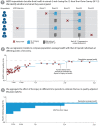Estimates of Quality-Adjusted Life-Year Loss for Injuries in the United States
- PMID: 36482721
- PMCID: PMC10021113
- DOI: 10.1177/0272989X221141454
Estimates of Quality-Adjusted Life-Year Loss for Injuries in the United States
Abstract
Purpose: The goal of this study is to develop an approach for estimating nationally representative quality-adjusted life-year (QALY) loss from injury and poisoning conditions using data collected in the Medical Expenditure Panel Survey (MEPS) and the National Health Interview Survey (NHIS).
Methods: This study uses data from the 2002-2015 NHIS and MEPS surveys. Injuries were identified in the MEPS medical events file and through self-reporting of medical conditions. We restricted our model to 163,731 adults, for which we predict a total of 294,977 EQ-5D scores using responses to the self-administered questionnaire. EQ-5D scores were modeled using age, sex, comorbidities, and binary indicators of the presence and duration of injury at the time of the health status questionnaire. These models consider nonlinearity over time during the first 3 y following the injury event.
Results: Injuries are identified in MEPS using medical events that provide a reasonable proxy for the date of injury occurrence. Health-related quality of life (HRQL) decrements can be estimated using binary indicators of injury during different time periods. When grouped into 29 injury categories, most categories were statistically significant predictors of HRQL scores in the first year after injury. For these groups of injuries, mean first-year QALY loss estimates range from 0.005 (sprains and strains of joints and adjacent muscles, n = 7067) to 0.109 (injury to nerves and spinal cord, n = 71). Fewer estimates are significant in the second and third years after injury, which may reflect a return to baseline HRQL.
Conclusion: This research presents both a framework for estimating QALY loss for short-lived medical conditions and nationally representative, community-based HRQL scores associated with a wide variety of injury and poisoning conditions.
Highlights: This research provides a catalog of nationally representative, preference-based EQ-5D score decrements associated with surviving a large set of injuries, based on patient-reported health status.Mean first-year QALY loss estimates range from 0.005 (sprains and strains of joints and adjacent muscles, n = 7067) to 0.109 (injury to nerves and spinal cord, n = 71).This article presents a novel methodology for assessing quality-of-life impacts for acute conditions by calculating the time elapsed between injury and health status elicitation. Researchers may explore adapting these methods to study other short-lived conditions and health states, such as COVID-19 or chemotherapy.
Keywords: EQ-5D; HRQoL; MEPS; NHIS; QALY; RQL; SF-12; SF-6D; health measurement; injury.
Conflict of interest statement
The authors declared no potential conflicts of interest with respect to the research, authorship, and/or publication of this article. The authors disclosed receipt of the following financial support for the research, authorship, and/or publication of this article: Financial support for this study was provided in part by contracts with the United States Consumer Product Safety Commission and United States Coast Guard. The funding agreement ensured the authors’ independence in designing the study, interpreting the data, writing, and publishing the findings.
Figures
References
-
- Gold MR, Siegel JE, Russell LB, Weinstein MC, eds. Cost-Effectiveness in Health and Medicine. New York: Oxford University Press; 1996.
-
- Ogwulu CB, Jackson LJ, Kinghorn P, Roberts TE. A systematic review of the techniques used to value temporary health states. Value Health. 2017;20(8):1180–97. - PubMed
-
- Stoniute J, Mott DJ, Shen J. Challenges in valuing temporary health states for economic evaluation: a review of empirical applications of the chained time trade-off method. Value Health. 2018;21(5):605–11. - PubMed
-
- Wright DR, Wittenberg E, Swan JS, Miksad RA, Prosser LA. Methods for measuring temporary health states for cost-utility analyses. Pharmacoeconomics 2009;27(9):713–23. - PubMed
Publication types
MeSH terms
LinkOut - more resources
Full Text Sources
Medical



